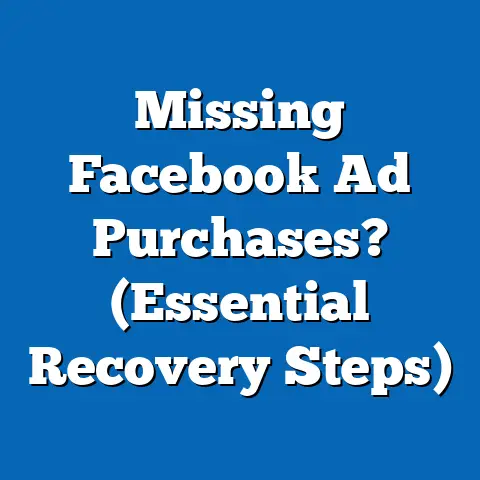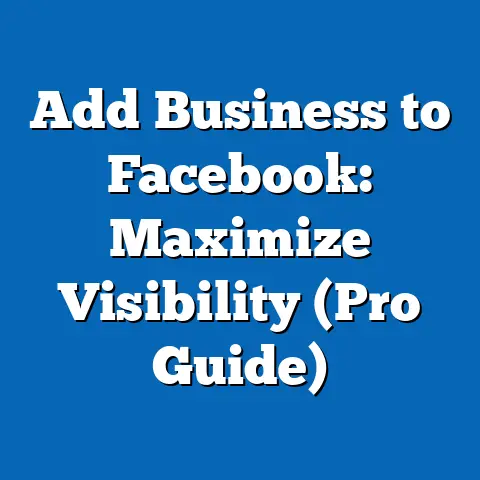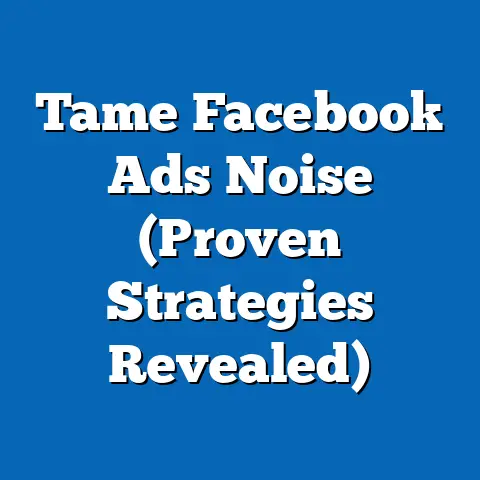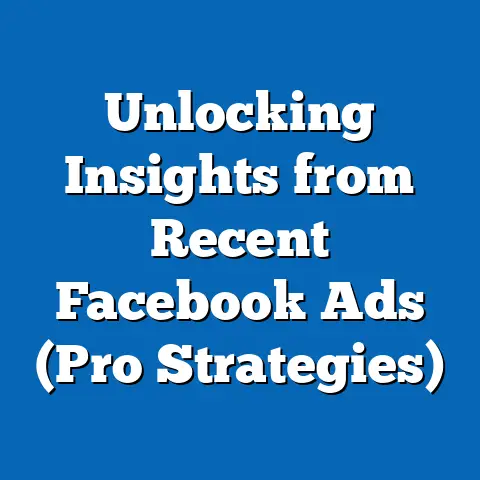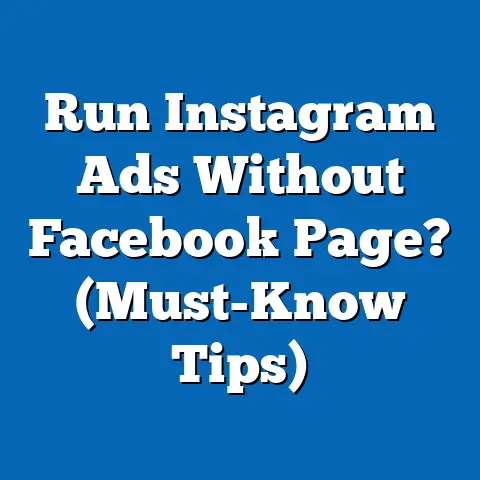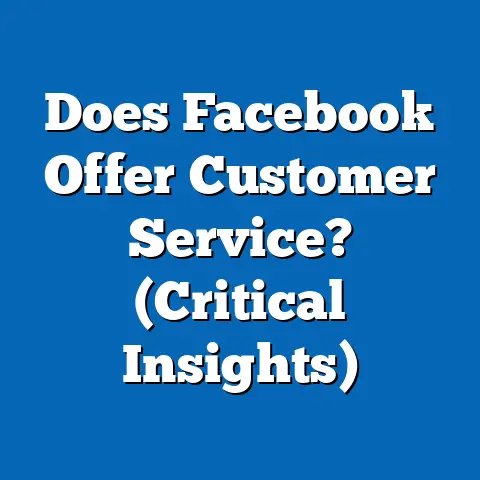Revitalize Facebook Ads Today (Game-Changing Strategies)
Facebook ads. They’re a staple in almost every digital marketer’s toolkit, and for good reason. But let’s be honest, how many times have you felt like your carefully crafted campaigns are just… fizzling? The truth is, the digital landscape is in constant flux. Consumer behavior is evolving, and what worked last year might not even get a glance today. To truly succeed, we need to move beyond generic targeting and delve into the heart of what motivates our audience: their lifestyles.
I’ve seen firsthand how a deep understanding of lifestyle needs can transform a mediocre Facebook ad campaign into a roaring success. One time, I was working with a local fitness studio struggling to attract new members. We weren’t just selling gym memberships; we were selling a lifestyle of health, wellness, and community. By revamping their ads with visuals showcasing active people enjoying outdoor activities and highlighting the studio’s community events, we saw a 30% increase in lead generation within the first month!
That’s why I’m so passionate about exploring revolutionary strategies that can breathe new life into your Facebook ad campaigns. In this guide, I’ll share my insights on how to tap into your audience’s lifestyle needs, create compelling ad content that resonates, leverage advanced targeting techniques, utilize video and visual content effectively, analyze performance, and stay ahead of the curve in the ever-evolving world of Facebook advertising.
Key Takeaway: Understanding and catering to your audience’s lifestyle needs is crucial for creating impactful and successful Facebook ad campaigns. Let’s dive in and explore how to make it happen!
Section 1: Understanding Your Audience’s Lifestyle Needs
What exactly are “lifestyle needs,” and why should we, as advertisers, care about them? Simply put, lifestyle needs are the values, interests, activities, and opinions that define how a person lives their life. They’re the driving forces behind their purchasing decisions, the content they engage with, and the brands they choose to support.
Think about it: someone who identifies as a “minimalist” isn’t going to be swayed by ads promoting excessive consumption. A “health-conscious” individual will likely be drawn to ads highlighting organic and sustainable products. Understanding these nuances is the key to creating ads that feel authentic and relevant.
Different Lifestyle Segments:
The beauty of Facebook is its ability to target incredibly specific audiences. Here are a few examples of lifestyle segments and how they might influence purchasing decisions:
- Health-Conscious: This segment prioritizes physical and mental well-being. They’re likely to be interested in organic food, fitness products, meditation apps, and eco-friendly cleaning supplies. I once ran a campaign for a local yoga studio targeting this segment with ads showcasing the studio’s calming atmosphere and experienced instructors. The response was phenomenal, with a significant increase in class bookings.
- Eco-Friendly: This segment is passionate about sustainability and reducing their environmental impact. They’re drawn to brands that offer eco-friendly products, support ethical sourcing, and promote environmental conservation. For example, I worked with a company selling reusable water bottles and targeted this segment with ads highlighting the bottles’ durability, eco-friendly materials, and impact on reducing plastic waste.
- Tech-Savvy: This segment is always on the lookout for the latest gadgets and technologies. They’re early adopters who are willing to spend money on innovative products that improve their lives. Ads targeting this segment should focus on the features, benefits, and cutting-edge technology of the product.
- Budget-Conscious: This segment is always looking for the best deals and value for their money. They’re likely to be interested in discounts, coupons, and affordable alternatives. Ads targeting this segment should focus on the price point, savings, and value proposition of the product.
- Travel Enthusiasts: This segment loves exploring new places and experiencing different cultures. They’re likely to be interested in travel deals, adventure gear, and cultural experiences. Ads targeting this segment should focus on the destination, unique experiences, and convenience.
Examples of Successful Facebook Ad Campaigns:
- Dove’s “Real Beauty” Campaign: This campaign resonated with women by challenging traditional beauty standards and promoting self-acceptance. It tapped into the lifestyle need for authenticity and self-love.
- Airbnb’s “Live There” Campaign: This campaign appealed to travelers seeking authentic experiences by showcasing unique accommodations and local neighborhoods. It tapped into the lifestyle need for adventure and cultural immersion.
- Patagonia’s “Don’t Buy This Jacket” Campaign: This campaign promoted sustainability by encouraging consumers to repair and reuse their clothing instead of buying new ones. It tapped into the lifestyle need for environmental responsibility.
Tools and Methods for Researching Audience Lifestyles:
- Facebook Audience Insights: This tool provides valuable data about your target audience’s demographics, interests, behaviors, and page likes. I’ve used it countless times to uncover hidden interests and lifestyle preferences that I wouldn’t have considered otherwise.
- Surveys: Creating and distributing surveys can provide direct insights into your audience’s lifestyle needs. Ask questions about their values, interests, activities, and purchasing habits.
- Social Listening: Monitor social media conversations to understand what your target audience is talking about and what’s important to them. Tools like Brandwatch and Mention can help you track mentions of your brand, industry keywords, and competitor activity.
- Competitor Analysis: Analyze your competitors’ Facebook ad campaigns to see what’s working for them and what’s not. Pay attention to their targeting, messaging, and visuals.
- Customer Personas: Develop detailed customer personas that represent your ideal customers. Include information about their demographics, interests, behaviors, lifestyle needs, and pain points.
Actionable Steps:
- Identify your target audience: Who are you trying to reach? What are their demographics, interests, and behaviors?
- Research their lifestyle needs: What are their values, interests, activities, and opinions?
- Use Facebook Audience Insights: Explore the tool to uncover hidden interests and lifestyle preferences.
- Create customer personas: Develop detailed customer personas that represent your ideal customers.
Key Takeaway: By understanding your audience’s lifestyle needs, you can create Facebook ad campaigns that are more relevant, engaging, and effective. It’s about moving beyond generic targeting and truly connecting with your audience on a personal level.
Section 2: Crafting Compelling Ad Content
Now that you understand your audience’s lifestyle needs, it’s time to craft compelling ad content that resonates with them. This is where the magic happens – where you transform your product or service into something that aligns with their values, aspirations, and desires.
Elements of Compelling Ad Content:
- Relevance: Your ad content should be directly relevant to your audience’s lifestyle needs. If you’re targeting health-conscious individuals, your ad should highlight the health benefits of your product.
- Engagement: Your ad content should be engaging and capture your audience’s attention. Use compelling visuals, captivating headlines, and persuasive copy.
- Value: Your ad content should offer value to your audience. This could be in the form of information, entertainment, or a special offer.
- Authenticity: Your ad content should be authentic and genuine. Avoid using hype or exaggeration. Be transparent about your product or service and its benefits.
The Importance of Storytelling:
Storytelling is a powerful tool for humanizing your brand and connecting with your audience on an emotional level. When you tell a story, you’re not just selling a product; you’re selling an experience, a feeling, a connection.
I remember working with a local coffee shop that wanted to increase its lunchtime sales. Instead of just showcasing their menu items, we created a series of short videos telling the stories of their loyal customers and how the coffee shop was a part of their daily routine. The videos resonated with the local community, and the coffee shop saw a significant increase in lunchtime traffic.
Tips for Writing Engaging Copy:
- Know your audience: Understand their language, tone, and interests.
- Use strong verbs: Verbs that convey action and excitement.
- Highlight the benefits: Focus on how your product or service will improve their lives.
- Create a sense of urgency: Encourage them to take action now.
- Use social proof: Show them that others have benefited from your product or service.
- Keep it concise: Get to the point quickly and avoid jargon.
Choosing the Right Visuals:
Your visuals are just as important as your copy. They should be high-quality, visually appealing, and relevant to your audience’s lifestyle needs.
- Use authentic images: Avoid using stock photos that look generic and staged.
- Showcase your product in action: Demonstrate how your product or service is used in real life.
- Use video: Video is a powerful tool for capturing attention and conveying your message.
- Use bright colors: Colors that are visually appealing and eye-catching.
- Use consistent branding: Ensure that your visuals are consistent with your brand’s identity.
Case Studies of Brands Aligning Messaging with Lifestyle:
- REI: This outdoor retailer aligns its messaging with the lifestyle of adventure seekers by showcasing stunning visuals of outdoor activities and promoting sustainable practices.
- Lululemon: This athletic apparel brand aligns its messaging with the lifestyle of health-conscious individuals by promoting yoga, fitness, and mindfulness.
- Warby Parker: This eyewear brand aligns its messaging with the lifestyle of socially conscious consumers by donating a pair of glasses to someone in need for every pair purchased.
Actionable Steps:
- Develop a brand story: What’s your brand’s mission, values, and purpose?
- Write compelling ad copy: Use strong verbs, highlight the benefits, and create a sense of urgency.
- Choose the right visuals: Use authentic images, showcase your product in action, and use video.
- Align your messaging with your audience’s lifestyle: Speak to their values, aspirations, and desires.
Key Takeaway: Crafting compelling ad content is about understanding your audience’s lifestyle needs and creating a message that resonates with them on an emotional level. It’s about telling a story, using engaging copy, and choosing the right visuals to capture their attention and inspire them to take action.
Section 3: Leveraging Advanced Targeting Techniques
Facebook’s targeting capabilities are truly remarkable. We’re not just throwing ads out into the digital void; we’re surgically targeting specific groups of people based on their demographics, interests, behaviors, and connections. But to truly revitalize your Facebook ads, you need to go beyond the basics and leverage advanced targeting techniques.
Facebook’s Targeting Options:
- Demographic Targeting: This allows you to target users based on their age, gender, location, education, income, and other demographic factors.
- Interest-Based Targeting: This allows you to target users based on their interests, hobbies, and passions.
- Behavioral Targeting: This allows you to target users based on their online behavior, such as their purchasing history, website visits, and app usage.
- Custom Audiences: This allows you to target users who have interacted with your business in the past, such as website visitors, email subscribers, and customers.
- Lookalike Audiences: This allows you to target users who are similar to your existing customers.
The Significance of Custom Audiences:
Custom audiences are a goldmine for targeted advertising. These are people who have already shown an interest in your brand, and they’re far more likely to convert than cold traffic.
- Website Visitors: Target users who have visited your website but haven’t made a purchase.
- Email Subscribers: Target users who have subscribed to your email list but haven’t purchased anything.
- Customers: Target existing customers with special offers and promotions.
I had a client who was struggling to re-engage past customers. We created a custom audience of everyone who had purchased from them in the last year and targeted them with a special “Welcome Back” discount. The campaign was incredibly successful, generating a significant increase in sales.
The Power of Lookalike Audiences:
Lookalike audiences are a fantastic way to expand your reach and find new customers who are similar to your existing ones. Facebook analyzes the characteristics of your custom audience and identifies other users who share those same traits.
- Source Audience: Choose a high-quality source audience, such as your best customers or website visitors.
- Audience Size: Select an audience size that’s large enough to provide Facebook with enough data but not so large that it becomes too broad.
- Location: Choose the location you want to target.
Actionable Steps for Creating Effective Ad Sets:
- Define your target audience: Who are you trying to reach? What are their demographics, interests, and behaviors?
- Create custom audiences: Target users who have interacted with your business in the past.
- Create lookalike audiences: Expand your reach and find new customers who are similar to your existing ones.
- Test different targeting options: Experiment with different combinations of demographics, interests, and behaviors to see what works best.
- Monitor your results: Track your key performance indicators (KPIs) to see how your ad sets are performing.
The Effectiveness of Retargeting Strategies:
Retargeting is a powerful strategy for keeping your brand top-of-mind and encouraging users to take action. It involves showing ads to users who have previously interacted with your website or app.
- Website Retargeting: Show ads to users who have visited your website but haven’t made a purchase.
- Product Retargeting: Show ads for specific products that users have viewed on your website.
- Cart Abandonment Retargeting: Show ads to users who have added items to their cart but haven’t completed the checkout process.
Key Takeaway: Leveraging advanced targeting techniques is essential for revitalizing your Facebook ads. By creating custom audiences, lookalike audiences, and retargeting strategies, you can reach the right people with the right message at the right time.
Section 4: Utilizing Video and Visual Content
In today’s fast-paced digital world, visual content reigns supreme. And within that realm, video is king. Facebook users are bombarded with information every second, so you need to grab their attention quickly and effectively. Video and high-quality visuals are your best weapons in this battle for attention.
The Rise of Video Content:
Video content is more engaging than static images or text. It allows you to tell a story, showcase your product in action, and connect with your audience on an emotional level. According to a recent study, video ads on Facebook generate 10-15% more clicks than static image ads.
Strategies for Creating Lifestyle-Driven Video Campaigns:
- Tutorials: Create videos that teach your audience how to use your product or service.
- Testimonials: Feature real customers sharing their positive experiences with your brand.
- Behind-the-Scenes: Give your audience a glimpse into your company culture and values.
- Product Demos: Showcase the features and benefits of your product in a visually appealing way.
- Lifestyle Vlogs: Create videos that align with your audience’s lifestyle, such as travel vlogs, cooking demonstrations, or fitness routines.
I once worked with a travel agency that wanted to promote its adventure tours. We created a series of short videos showcasing the stunning scenery, thrilling activities, and unique cultural experiences that were a part of the tours. The videos were incredibly engaging, and the travel agency saw a significant increase in bookings.
The Importance of High-Quality Visuals:
Even if you’re not using video, high-quality visuals are essential for capturing attention and conveying your message.
- Use professional photography: Avoid using blurry or low-resolution images.
- Use eye-catching graphics: Create graphics that are visually appealing and easy to understand.
- Use consistent branding: Ensure that your visuals are consistent with your brand’s identity.
- Optimize your images for Facebook: Use the recommended image sizes and file formats.
Examples of Brands Excelling in Video for Facebook Ads:
- GoPro: This action camera brand uses stunning videos showcasing its products in action.
- Nike: This athletic apparel brand uses inspiring videos featuring athletes and everyday people achieving their goals.
- Dollar Shave Club: This subscription razor brand uses humorous videos to promote its products.
Actionable Steps:
- Create a video marketing strategy: What types of videos will you create? What are your goals?
- Invest in high-quality equipment: Use a good camera, microphone, and editing software.
- Tell a story: Connect with your audience on an emotional level.
- Use eye-catching visuals: Capture their attention and convey your message effectively.
- Optimize your videos for Facebook: Use the recommended video sizes and file formats.
Key Takeaway: Utilizing video and high-quality visuals is crucial for revitalizing your Facebook ads. By creating engaging video content and using visually appealing images, you can capture your audience’s attention, convey your message effectively, and drive results.
Section 5: Analyzing Performance and Iterating Strategies
Creating compelling ads and targeting the right audience is only half the battle. The real magic happens when you start analyzing your performance and iterating on your strategies based on data. This is where you move from guesswork to informed decision-making, and it’s the key to long-term success with Facebook advertising.
The Importance of Data Analysis:
Data analysis allows you to understand what’s working and what’s not. It helps you identify areas for improvement and optimize your campaigns for better results. Without data analysis, you’re just flying blind.
Key Performance Indicators (KPIs) to Track:
- Reach: The number of unique people who saw your ad.
- Impressions: The number of times your ad was displayed.
- Click-Through Rate (CTR): The percentage of people who clicked on your ad after seeing it.
- Conversion Rate: The percentage of people who completed a desired action after clicking on your ad, such as making a purchase or filling out a form.
- Cost Per Click (CPC): The average cost you pay for each click on your ad.
- Cost Per Conversion (CPC): The average cost you pay for each conversion.
- Return on Ad Spend (ROAS): The amount of revenue you generate for every dollar you spend on advertising.
How KPIs Relate to Lifestyle Engagement:
When you’re targeting specific lifestyle segments, it’s important to track how your ads are resonating with those groups. Are they clicking on your ads? Are they converting? Are they engaging with your content?
For example, if you’re targeting health-conscious individuals with an ad for organic protein powder, you should track the CTR and conversion rate for that specific segment. If you’re seeing a high CTR but a low conversion rate, it might indicate that your ad is appealing but your product isn’t meeting their needs.
A Framework for Analyzing Ad Performance:
- Set clear goals: What are you trying to achieve with your Facebook ad campaigns?
- Track your KPIs: Monitor your key performance indicators regularly.
- Identify trends: Look for patterns in your data.
- Analyze your results: What’s working and what’s not?
- Make adjustments: Optimize your campaigns based on your findings.
Insights on A/B Testing:
A/B testing is a powerful tool for finding the most effective ad elements. It involves creating two versions of an ad, changing one element at a time, and then tracking which version performs better.
- Test different headlines: Which headline generates the most clicks?
- Test different visuals: Which visual captures the most attention?
- Test different calls to action: Which call to action encourages the most conversions?
- Test different targeting options: Which targeting options generate the best results?
Actionable Steps:
- Set up Facebook Pixel: This tool tracks user behavior on your website and allows you to measure conversions.
- Track your KPIs: Monitor your key performance indicators regularly.
- Analyze your results: What’s working and what’s not?
- A/B test different ad elements: Find the most effective headlines, visuals, calls to action, and targeting options.
- Make adjustments: Optimize your campaigns based on your findings.
Key Takeaway: Analyzing performance and iterating strategies is crucial for optimizing your Facebook ad campaigns and achieving your goals. By tracking your KPIs, identifying trends, and A/B testing different ad elements, you can make data-driven decisions that improve your results.
Section 6: Staying Ahead of Trends in Facebook Advertising
The world of Facebook advertising is constantly evolving. New features are released, algorithms are updated, and consumer behavior shifts. To stay ahead of the curve and continue to revitalize your Facebook ads, you need to be aware of the latest trends and adapt your strategies accordingly.
Current and Emerging Trends:
- Artificial Intelligence (AI) and Machine Learning (ML): AI and ML are increasingly being used to optimize ad delivery, targeting, and creative. Facebook’s Advantage+ campaign budget is a prime example.
- Personalization: Consumers expect personalized experiences. Use data to tailor your ads to individual users based on their interests, behaviors, and past interactions.
- Augmented Reality (AR): AR is being used to create immersive and engaging ad experiences.
- Short-Form Video: Short-form video content, like Reels, is becoming increasingly popular on Facebook.
- Social Commerce: Facebook is making it easier for users to purchase products directly from the platform.
The Role of AI and ML in Optimizing Ad Delivery:
AI and ML can help you optimize your ad delivery by automatically adjusting your bids, targeting, and creative based on real-time data. This can save you time and improve your results.
Predictions on the Evolution of Lifestyle Marketing on Facebook:
- More personalized ads: Ads will become even more personalized based on individual user data.
- More immersive experiences: AR and VR will be used to create more immersive ad experiences.
- More social commerce: Facebook will become a major player in the e-commerce space.
- More AI-powered optimization: AI and ML will continue to play a larger role in optimizing ad campaigns.
Encouraging Innovation and Adaptability:
The key to staying ahead of the curve is to embrace innovation and adaptability. Be willing to experiment with new features, test different strategies, and learn from your mistakes.
Actionable Steps:
- Stay informed: Read industry blogs, attend webinars, and follow social media experts.
- Experiment with new features: Test out the latest Facebook ad features.
- Analyze your results: Track your KPIs and see what’s working and what’s not.
- Adapt your strategies: Adjust your campaigns based on your findings.
- Embrace innovation: Be willing to try new things.
Key Takeaway: Staying ahead of trends in Facebook advertising is crucial for revitalizing your campaigns and achieving long-term success. By embracing innovation, adapting your strategies, and staying informed about the latest developments, you can continue to reach your target audience and drive results.
Conclusion
We’ve covered a lot of ground in this guide, exploring the game-changing strategies that can revitalize your Facebook ad campaigns. From understanding your audience’s lifestyle needs to crafting compelling ad content, leveraging advanced targeting techniques, utilizing video and visual content effectively, analyzing performance, and staying ahead of trends, you now have the knowledge and tools to take your Facebook advertising to the next level.
Remember, the key to success is to align your Facebook ads with your audience’s lifestyle needs. This means understanding their values, aspirations, and desires, and creating a message that resonates with them on an emotional level.
The landscape of social media advertising is constantly evolving, so it’s essential to stay informed, experiment with new strategies, and adapt your campaigns accordingly. Continuous learning and adaptation are the keys to long-term success.
I encourage you to implement the strategies outlined in this guide and see the transformative impact they can have on your Facebook ad campaigns. Don’t be afraid to experiment, test new ideas, and learn from your mistakes. The world of Facebook advertising is full of opportunities, and with the right approach, you can achieve your goals and drive significant results for your business.
Now go out there and revitalize your Facebook ads!
Key Takeaways:
- Understanding your audience’s lifestyle needs is crucial for creating impactful and successful Facebook ad campaigns.
- Crafting compelling ad content is about connecting with your audience on an emotional level.
- Leveraging advanced targeting techniques is essential for reaching the right people with the right message.
- Utilizing video and high-quality visuals is crucial for capturing attention and conveying your message effectively.
- Analyzing performance and iterating strategies is crucial for optimizing your campaigns and achieving your goals.
- Staying ahead of trends in Facebook advertising is crucial for revitalizing your campaigns and achieving long-term success.
Call to Action
I’d love to hear about your experiences in implementing these strategies and the outcomes you’ve achieved. Share your stories, insights, and questions in the comments below. Let’s learn from each other and continue to improve our Facebook advertising skills together.
Also, I encourage you to stay engaged with the evolving Facebook ads landscape and explore further resources for continued learning. There are countless articles, blogs, and courses available to help you master the art of Facebook advertising. Don’t be afraid to invest in your knowledge and skills. The more you learn, the better you’ll become at driving results for your business.

